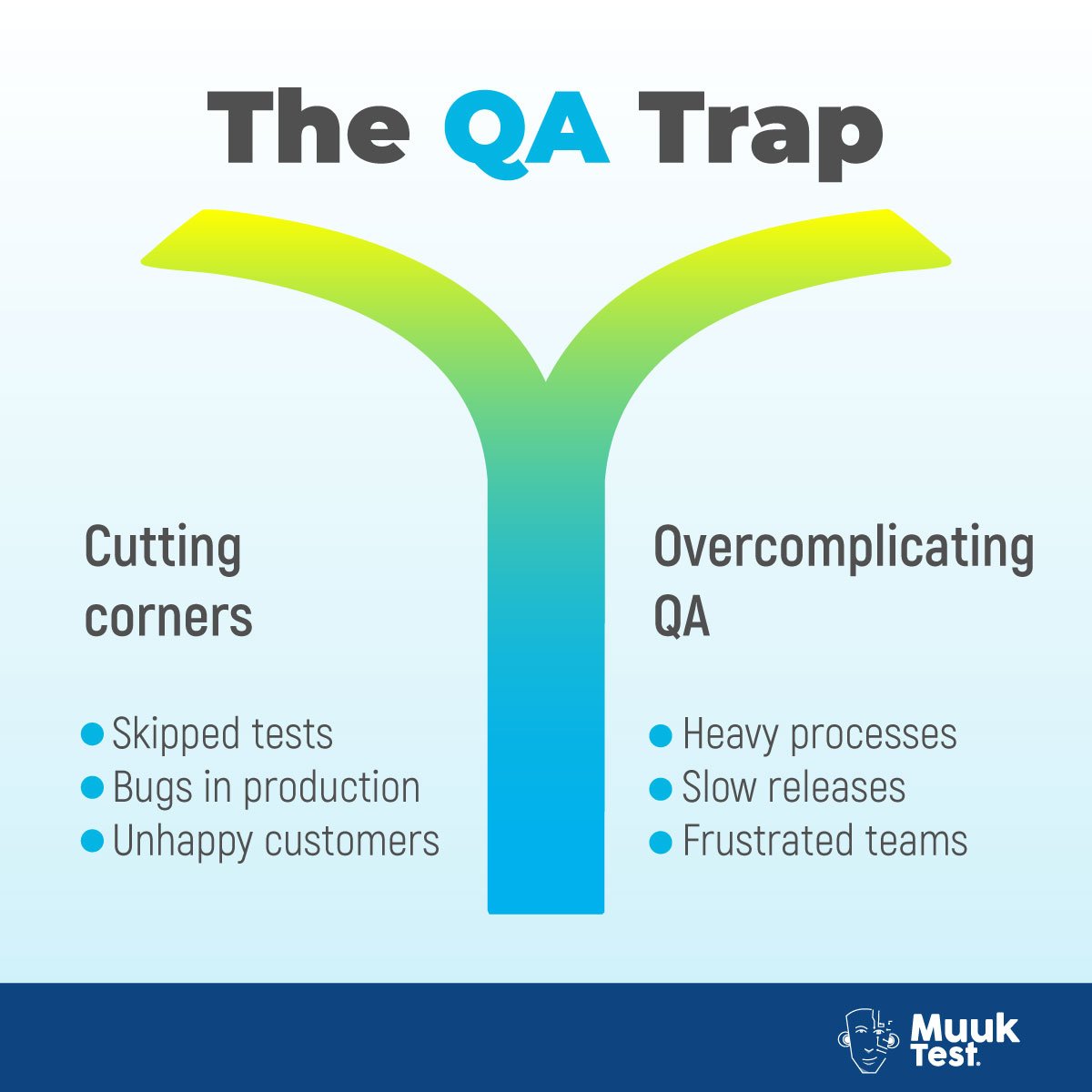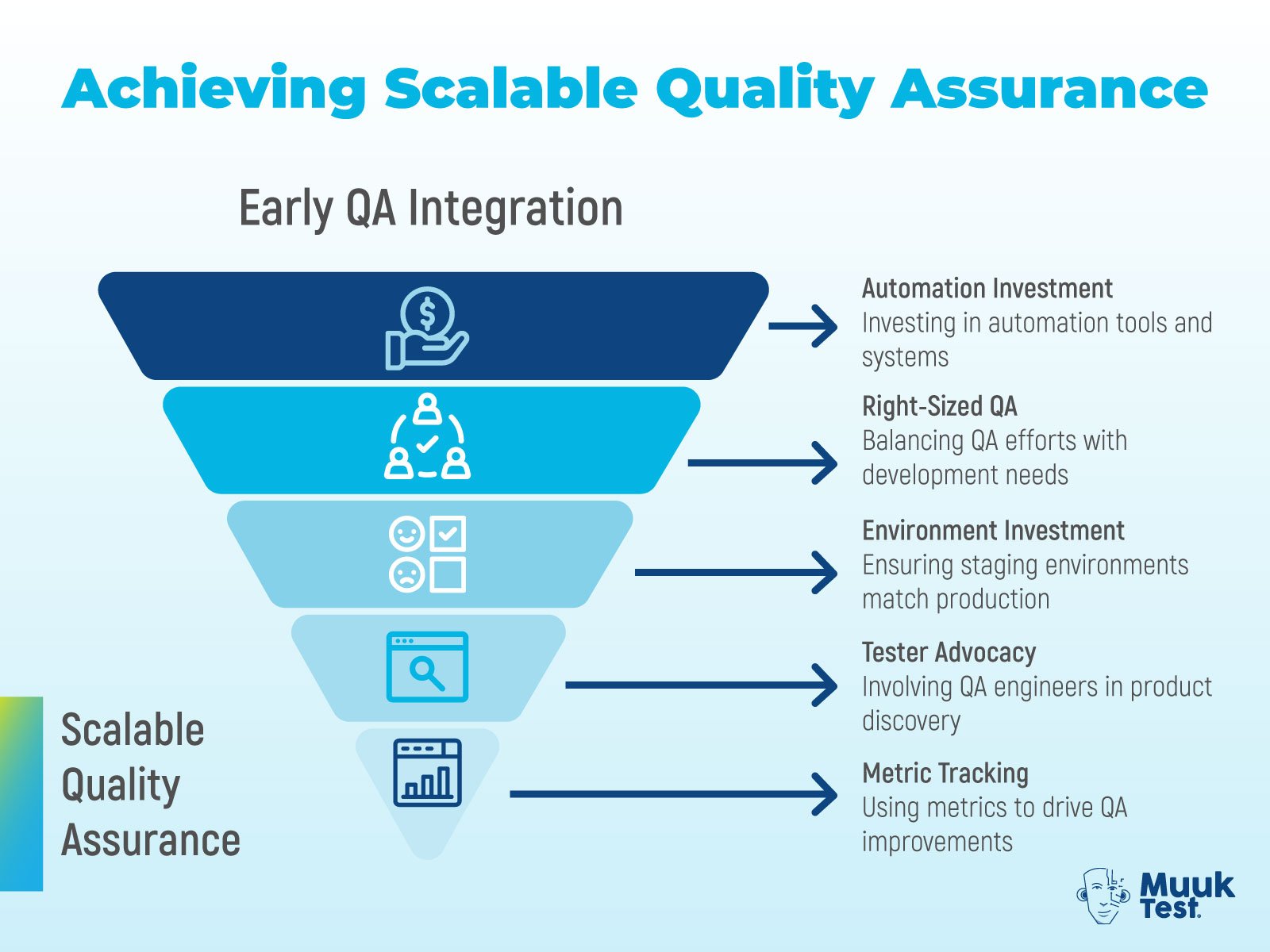-
The QA Trap is real: Scaling startups often sacrifice quality for speed or drown in heavy processes, leading to stalled growth and unhappy customers.
-
Balance is everything: The right QA strategy enables both speed and trust. Culture, automation, environments, and metrics are all part of the equation.
-
Real-world proof: From Facebook to Uber, Nokia to Zoom, even the biggest names have stumbled into the QA trap and escaped by evolving their approach.
-
Startups can avoid it: Embedding QA early, automating wisely, and empowering QA engineers as advocates helps companies scale faster and more reliably.

Once we are in a startup, our primary goal is speed. Every startup begins with speed as its greatest advantage. In the early days, despite the team being very small and scrappy, they can ship features rapidly, they can pivot overnight, and make the customers very happy before the competitors even realize what has happened.
But somewhere between the seed round and Series B fundraising rounds, when the user numbers grow and the teams expand, a familiar trap emerges. Without even realizing it, many scaling startups quietly get crippled, and this is what I like to call the Quality Assurance Trap.
This trap is simple. As startups scale, quality often takes a backseat to speed. The founders and engineering leaders are under constant pressure to release new features rapidly. The investors want traction, the customers demand enhancements, and the competitors keep innovating. To satisfy all of them and to keep pace, testing becomes a bottleneck.
So what are the next steps? Some teams cut corners. Testing gets rushed, manual checks get skipped, and the “we'll fix it later” mentality spreads.
Other startups react in the opposite way. They introduce bloated QA processes, exhaustive test cycles, and approval gates that slow the releases to a crawl.
In both of these cases, the outcome is the same. The teams are frustrated, the customers remain unhappy, and the momentum is lost.
Why Do Scaling Startups Fall Into the QA Trap?
History shows that scaling startups without a balanced QA strategy face higher risks of stalled growth, buggy releases, and lost customer trust. Below are three well-known examples that illustrate how different approaches to QA, too little or too much, can slow even the most promising companies.
1. Early Stage Agility Myth
Facebook popularized the phrase, “Move fast and break things”. They used it as their mantra. It worked when they had millions of young college users. But by 2014, after repeated privacy and outage scandals, Mark Zuckerberg famously declared: ”Move fast with stable infrastructure”. That shift was essentially Facebook escaping its QA trap.
2. Underestimating QA as a Discipline
In the case of Uber, when they were scaling in their early years, a lack of proper regression testing caused repeated payment glitches and map rendering bugs. Both the drivers and the riders got frustrated. Uber later invested heavily in automation and end-to-end integration testing frameworks to stabilize the platform.
3. Overcompensating with Heavy Processes
Nokia, before its smartphone collapse, became a cautionary tale. By overloading itself with heavy QA processes and approval layers, the innovation slowed to a crawl while Apple and Android, at the same time, leapfrogged. It's proof that excessive QA bureaucracy can kill agility as much as too little QA discipline.
How Can Startups Avoid the QA Trap and Scale Faster?
Avoiding the QA trap, or even escaping, is possible. The startups need to treat QA not as a gatekeeper, but as an enabler of speed, trust, and scale.
1. Building QA culture from day one
Slack embedded peer review and automated unit tests into its culture early. Every feature had test cases before merging, which let them scale without losing agility. The companies use the matrix “defect escape rate”, which is the bugs reported by customers versus those caught in testing. If you can keep it under 10%, the scaling can be rapid. For a deeper dive into how startups can embed QA practices early, check out this guide on creating a QA culture in startups.
2. Scaling successfully by investing in test automation
For example, the Netflix Chaos Monkey system deliberately breaks services in production to ensure resilience. By automating not just functional but chaos testing, Netflix achieved 99.99% availability even while deploying thousands of daily code changes.
3. Right-sized QA processes for sustainable growth
With thousands of contributors, GitLab avoided heavy test plans by relying on short test charters and CI-CD pipelines. Every merge triggered automated test runs across environments. This balance helped them achieve rapid release velocity while keeping defects in check.
4. Investing in scalable testing environments
Companies often struggle with staging environments not matching the production traffic, leading to bugs during peak seasons. For example, Airbnb, after facing these problems, invested heavily in synthetic test data and high-fidelity staging clusters, which improved its checkout success rate by 30% during high-demand events.
5. QA engineers as quality advocates in startups
In many companies, QA engineers are deeply involved in product discovery. By raising concerns about currency conversions, accessibility, and compliance before even the coding begins, they can avoid dozens of production issues.
6. QA metrics that drive startup growth
For example, Amazon obsessively tracks customer-reported defects per million transactions. Jeff Bezos famously mandated that “every defect counts as an opportunity for learning”. This makes QA a business metric and not just an engineering metric.
7. Preparing QA for scale before it’s too late
A brilliant example is Zoom, which anticipated scaling from 10 million to 300 million users daily during the pandemic. They stress-tested servers, load-tested APIs, and introduced performance chaos testing before usage exploded. While some hiccups occurred, proactive QA saved them from total collapse.
Real-World QA Lessons from Startups
From music streaming to payments and even self-driving cars, leading startups have shown that investing in the proper QA practices pays off. These companies turned quality into a competitive advantage, and their lessons highlight how startups can scale with both speed and reliability.
- Spotify: In 2016, Spotify’s recommendation engine began producing irrelevant playlists due to data quality issues. Their QA team built automated data validation pipelines, reducing bad recommendations by 85%.
- Stripe: Known for reliability, Stripe enforces a “no broken windows” QA culture. Even minor UI bugs are fixed before new features ship. This obsessive focus on polish helped them win trust from enterprises handling billions in payments.
- Airbnb: Introduced automated testing for pricing and availability algorithms. Before this, double-bookings plagued customers. Post-QA investments, their error rates in booking dropped significantly, improving customer trust.
- Tesla: Famously pushes OTA (over-the-air) updates but learned hard QA lessons — like the 2016 Autopilot crash. Since then, Tesla introduced shadow-mode testing, where updates run silently in parallel before being made active.
Escaping the QA Trap Without Losing Speed
Do not consider falling into the QA Trap as a sign of incompetence. It is a natural growing pain. Every scaling startup has faced it, from Uber to Slack to Airbnb. The danger lies in ignoring it or over-correcting it in the wrong direction.
The truth is, quality and speed are not against each other. If you have the right QA strategy, startups can move faster, safer, and smarter.
Embed the QA culture early, automate wisely, and empower your testers as strategic partners, who are the enablers. Such startups can escape the trap and maintain momentum without sacrificing trust.
Always remember that in the end, customers do not remember how fast you shipped a feature. They remember how reliably it worked.

Further Reading on QA for Scaling Startups
- https://marshallhargrave.medium.com/the-hidden-traps-that-derail-high-growth-startups-and-how-to-avoid-them-f9939f4d6598
- https://www.marketveep.com/blog/4-common-mistakes-scaling-startups-should-avoid
- https://review.firstround.com/the-dos-and-donts-of-rapid-scaling-for-startups/
Frequently Asked Questions
What is the QA trap that startups face when scaling?
The QA trap happens when startups either cut corners on testing to move fast or overcomplicate QA with overly complex processes. Both extremes create bottlenecks, leading to buggy releases, slower growth, and frustrated customers.
How can startups balance speed and quality in software development?
Startups should treat QA as an enabler, not a blocker. Lightweight automated testing, realistic staging environments, and meaningful QA metrics allow teams to release quickly while maintaining trust.
Why is QA important for startup growth?
Quality builds customer trust, and trust drives growth. A strong QA strategy reduces production bugs, prevents customer churn, and improves release velocity, all critical for scaling startups.
How can MuukTest help startups escape the QA trap?
MuukTest combines AI-powered test automation with expert QA services to give startups rapid, scalable coverage. Instead of slowing down, teams can embed QA early and move faster without sacrificing reliability.
What QA practices should scaling startups prioritize?
Focus on embedding QA culture from day one, investing in automation, preparing realistic environments, tracking defect escape rates, and empowering QA engineers as quality advocates. These practices keep growth sustainable.




%20(1).png?width=150&height=69&name=MuukTest-logo---light-background%20(3)%20(1).png)


